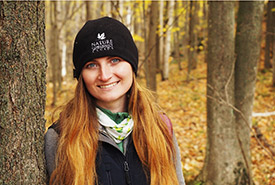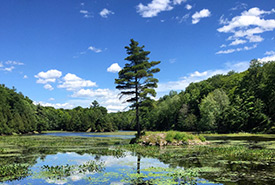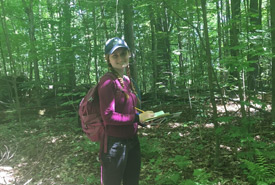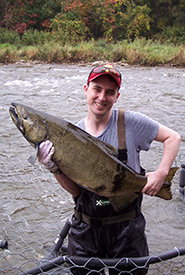The future of conservation is female (part three)

Megan Quinn, conservation biology coordinator in Ontario (Photo by Charles T. Low Photography)
In honour of International Women’s Day (March 8), over the course of the month we have been celebrating three young women working for the Nature Conservancy of Canada’s (NCC’s) Ontario Region. We spoke with them about what led them to a career in conservation and learned more about the important conservation work they do for their respective natural areas. So far we have spoken to Jenna Siu and Esme Batten, and this week we will conclude our series with Megan Quinn, acting coordinator of conservation biology for eastern Ontario.
NCC: How did you get involved with nature conservation?
Megan Quinn (MQ): I was born and grew up in the town of Rotherham in the north of England, which is about as far away from the natural world as you can get. It was only when I moved to Canada that I could really immerse myself in endless wilderness. I’ll never forget the first time I drove through Algonquin Park and marvelled at how massive it was.
I went to Sir Sandford Fleming College in Lindsay, Ontario, for ecosystem management, and I worked for a variety of non-profits and municipal agencies before finding myself at NCC in a full-time capacity, which for me is a dream come true.
Related blog posts
NCC: Tell us about the natural areas in eastern Ontario.
MQ: I coordinate the stewardship activities for eastern Ontario, which are focused in two major natural areas: The Ottawa Valley, which straddles the southern side of the Ottawa River, and the Frontenac Arch, which is north of Kingston and bridges the gap between the Adirondack Mountains and Algonquin Park.

A wetland in the Frontenac Arch, ON (Photo by NCC)
Eastern Ontario is comprised of a lot of forest and wetland, and I’m very lucky to work in some of the least disturbed areas of southern Ontario. Because of this, my area has a high population of species at risk, including many amphibians and reptiles.
NCC: Tell us about a particular species of interest in your natural area.
MQ: You might have heard recently that all eight species of native Ontario turtle are at risk of disappearing from the province. One of these is Blanding’s turtle. It is easily identified by its domed shell and bright yellow throat. It’s affectionately known as “Ontario’s smiling turtle” because the shape of its lower jaw makes it look like it’s smiling.
Unfortunately, Ontario's turtles are threatened by habitat fragmentation. With increased building and development, they have to cross more roads and residential areas to get to their nesting sites. They can sometimes nest on the gravel shoulders of roads, which also impacts their safety.
But in eastern Ontario, we get to make a difference. We are lucky to have a higher than usual number of them in the Frontenac Arch, compared to other areas. My team and I are working hard to protect their habitat and to educate the public about how they can help turtles. One of the big ways is by helping them cross roads and reporting when they see its “smiling face” when they’re out in nature.
NCC: As you look to the future, what do you see?

Megan Quinn working in the forest (Photo by NCC)
MQ: I think we’re at a very exciting time for conservation in Canada. Although, without a doubt, we are facing a lot of challenges, we also have more people than ever interested in making a difference and having a direct impact on the planet. Whether it’s spending time in nature, making a donation or keeping up to date with the work we do here at NCC, everyone has a role to play.
In the Frontenac Arch and eastern Ontario, I’m excited to add more pieces to the puzzle. Our goal for these areas is to create as much connected habitat as possible, because this is an important migration route. The larger the area we are able to protect, the easier it will be for these sensitive species to move around. It also gives me hope when I attend community events and people come up to me who know about conservation and are excited about the work we do.
NCC: Do you have a favourite story from your work at NCC?
MQ: This past summer, NCC successfully secured the Whitefish Lake property, thanks to the generous support of our donors. This property is located just north of Seeley’s Bay in the Frontenac Arch. This spectacular piece of our conservation puzzle has towering rock barrens, rich forest and 2.5 kilometres of pristine Rideau waterway shoreline.
One of my jobs as a conservation biologist is to inventory properties we acquire to get a better understanding of how to manage them. So, I recently took my four interns to the property for an overnight field survey. Just before dusk, we hiked up the side of a steep rock face, which opened up onto a flat, barren landscape. From the top of the property, we could see thousands of stars. We all just sat in silence admiring how beautiful it was. It really put into perspective how important the work we do is. If you ever have a chance to spend time in the Frontenac Arch, I highly recommend doing some stargazing.


